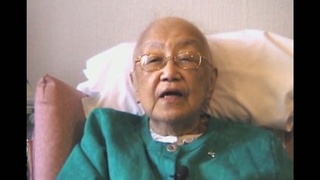Interviews
Choice to move east or go to Japan
The government said, I think United States and Canada knows Japan's gonna be... so before that, if you want to stay in Canada, move to east. Unless if you're gonna go Japan, you stay in Tashme. So the family in Tashme, we're the one family moved east. We're the first one, because when we moved, that day, it was a German was... so we were scared if a soldier saw us in the train, what... so Bob said, Just keep quiet, what they say everything, just keep quiet. Don't talk to them. But they didn't bother us. You know, they think we're Indian or something. [Laughs]
I*: How, how was the decision, because you could go to, I mean, the government will pay you to go to Japan, or move east. There was, how was that decision made?
Oh, yes, my father-in-law wants to go back to Japan. Of course, he was the oldest in the family, but I thought the younger one -- of course Miyoko speak Japanese and English both. But the others doesn't know how to speak Japanese. So I said, How could you take these girls to Japan? Well, good thing we didn't. Afterwards, we heard that they haven't got enough food, even the oldest family, my father-in-law was. You know, we haven't got the money. If you have lots of money to take to Japan is a different story. But those days, who got it, that kind of money? Especially we have to evacuate from their hometown and everything. So well, good thing we moved.
* "I" indicates an interviewer (Peter Wakayama).
Date: February 14, 2005
Location: Toronto, Canada
Interviewer: Peter Wakayama
Contributed by: Sedai, the Japanese Canadian Legacy Project, Japanese Canadian Cultural Center









